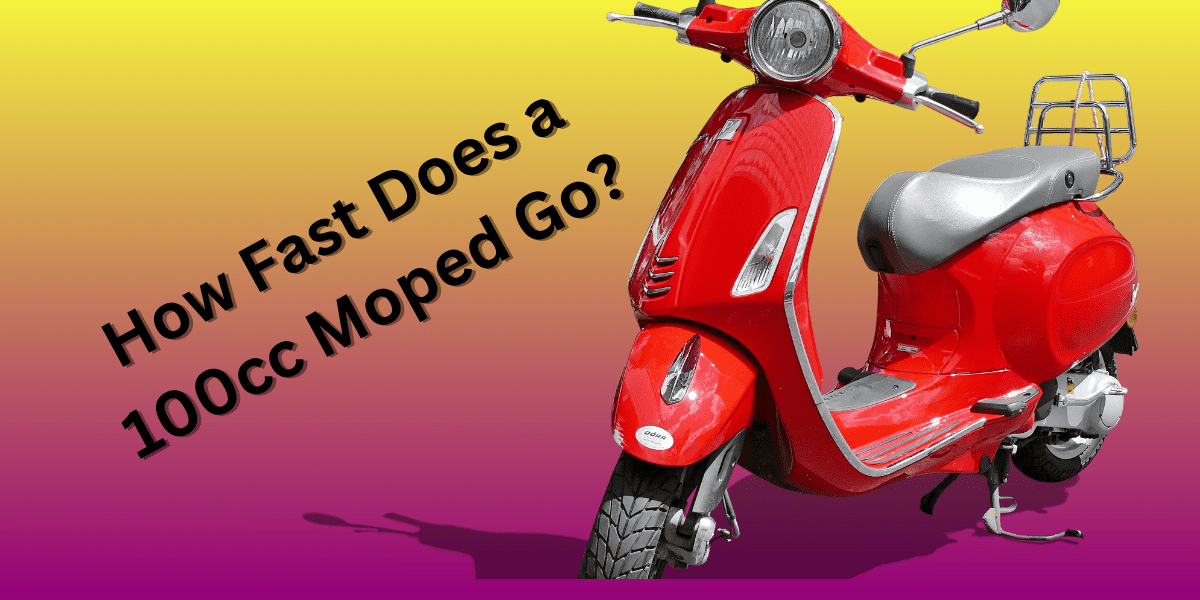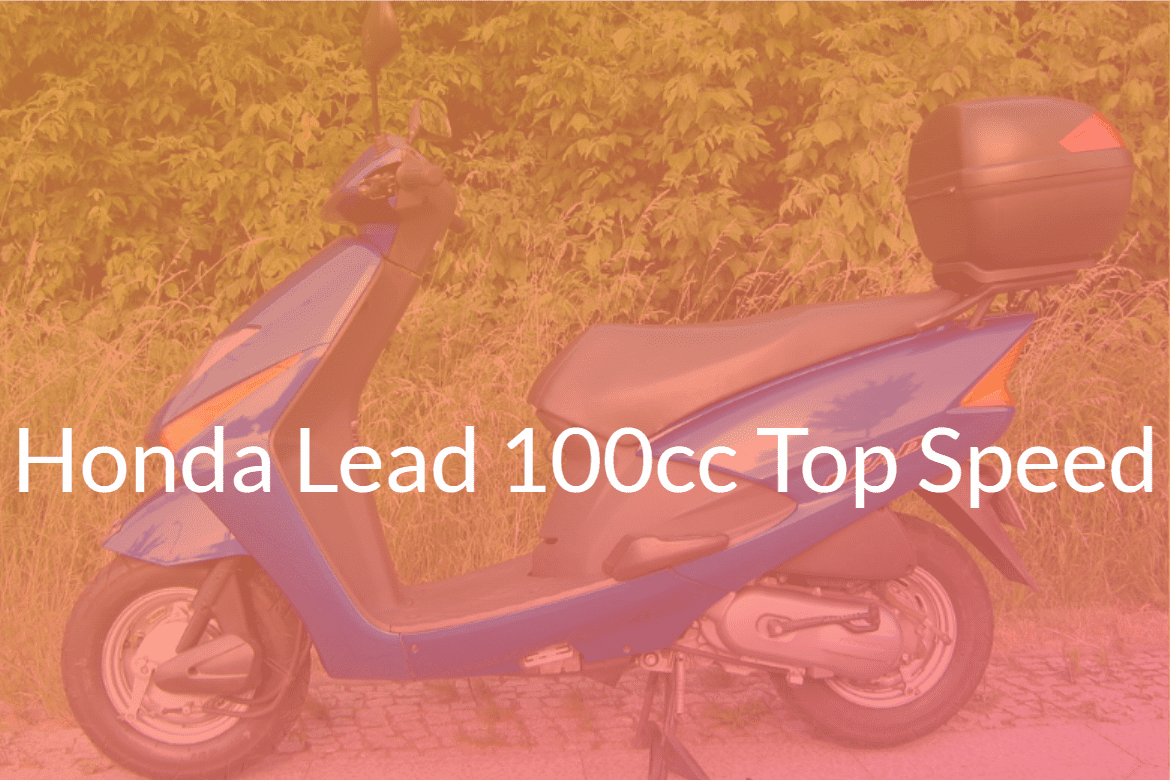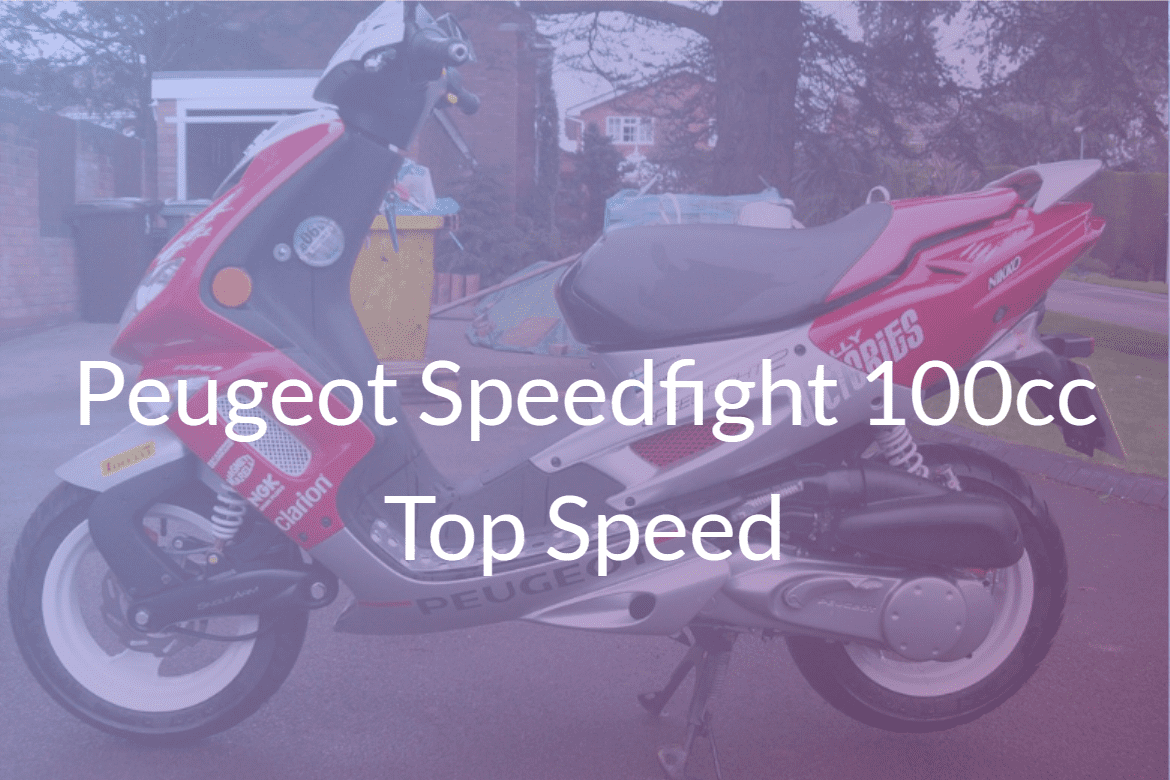Are you curious about the top speed of a 100cc moped? Look no further! While these nimble machines might not be as powerful as their 150cc siblings, they still offer a thrilling ride without any legal restrictions. If you’re wondering, “How fast does a 100cc moped go?” you’re in the right place.
In this article, we’ll dive into the world of 100cc mopeds and their maximum speeds.
We understand that every rider has their favorite brands and models, which is why we’ve included links to separate articles that provide detailed information on the top speeds of individual makes and models, including Piaggio, Honda, Yamaha, and more.
Click here to explore our library of moped top speeds and satisfy your curiosity.
How Fast Does a 100cc Moped Go?
If you’re curious about the top speed of a 100cc moped, you’re definitely not alone! Knowing how fast a moped can go is important, whether you’re thinking about buying one or just gathering information for fun.
To figure out the top speed of a 100cc moped, it helps to know about engine size. The “cc” in “100cc” stands for cubic centimeters, which is a way to measure the size of the engine. In general, the larger the engine, the faster the moped can go.
A 100cc engine is a pretty good size for a moped because it offers a mix of speed and control. There are bigger engines, like 250cc, that can make a moped go even faster. On the other hand, a smaller engine, like 50cc, will be slower.
From our experience, most 100cc mopeds can reach speeds of around 45-60 miles per hour (72-97 kilometers per hour).
Keep in mind that this number might be a bit different for each moped because they’re made by different companies and have unique designs. But it’s a good starting point to help you understand what to expect from a 100cc moped.
If you’re interested in specific moped models or wish to explore the top speeds of various 100cc mopeds, click on the table below.
We’ve examined popular mopeds top speeds. These aren’t your average vague responses—we’ve drawn from personal experience, engaged with moped owners, and scoured forums to bring you the precise top speed of each moped!
| Yamaha Aerox 100 | Yamaha Neos 100 |
| Peugeot Kisbee 100 | Peugeot Speedfight 100 |
| Honda Lead 100 | Piaggio Zip 100 |
Factors That Affect Top Speed
The top speed of a moped depends on several factors, not just the engine size. While a bigger engine usually means a faster moped, other things can also affect how fast it goes. Here are some things to keep in mind:
Weight
The weight of the rider, passengers, or any luggage can impact the moped’s top speed. A heavier load needs more power to move, which can slow down acceleration and reduce the top speed. To make your moped go faster and use less fuel, try to carry less stuff and avoid having passengers.
Terrain
The kind of road you’re riding on can make a difference too. Going uphill can slow you down, while flat, smooth roads can help you go faster. If you’re in an area with lots of hills, remember that your top speed might change depending on the road.
Wind Resistance
The shape of your moped can also affect how fast it goes because of wind resistance. If your moped has a chunky design or extra accessories, it might not be as aerodynamic and could have a slower top speed. To make your moped go faster, consider removing any unnecessary accessories and aim for a more streamlined shape.
Maintenance
Taking good care of your moped can help it reach its top speed. Regular maintenance, like oil changes, tire checks, and spark plug replacements, can keep your moped running smoothly. If you ignore maintenance, your moped might not perform as well and could have a slower top speed.
Remember, it’s essential to follow speed limits and not go too fast. Going too fast can lead to getting in trouble with the law or, even worse, having an accident. Stick to a legal and safe speed to protect yourself and others.
How to Increase a 100cc Moped Top Speed
There are a few ways to make your 100cc moped faster, some of which involve modifying your moped, while others are simpler. Keep in mind that making changes to your moped can be risky and might void your warranty.
Some of these suggestions need mechanical know-how, so if you’re not confident or don’t know much about mechanics, it’s better to have an expert do it for you. And, as always, feel free to ask us for advice – we’re here to help!
Here are a few things you can do to make your moped faster:
Upgrade the Exhaust
One way to make your 100cc moped faster is to upgrade the exhaust system. A better exhaust system can improve how exhaust gases leave the engine and make your moped more powerful, which can lead to higher speeds.
There are different types of exhaust systems, like slip-on exhausts and full exhaust systems. Slip-on exhausts replace just the muffler part and are cheaper and easier to install. Full exhaust systems replace the whole exhaust system and are more expensive and take longer to install.
Install a Performance Air Filter
A performance air filter can help your moped go faster by improving airflow to the engine. Upgrading the air filter can lead to more power and a higher top speed.
When you change the air filter, you also change the air-to-fuel ratio the engine needs to work properly. This is important because if the ratio isn’t right, your engine can get damaged. It’s best to have a professional mechanic or expert help you make adjustments to your moped’s fuel system.
Upgrade the Variator
The variator is a part of the moped’s transmission system that controls the gear ratio and adjusts the engine speed. Upgrading the variator can make your moped accelerate faster and have a higher top speed.
By modifying the weights or rollers in the variator and changing the size of the pulleys, the gear ratio can be adjusted to match your riding style and the road conditions.
Check Tire Pressure
Proper tire pressure can improve your moped’s performance, including acceleration, braking, and top speed. Make sure your tires are correctly inflated – underinflated tires can slow you down, while overinflated tires can make your moped harder to handle.
Use High-Quality Fuel
Using high-quality fuel can help your moped go faster. High-quality fuel burns more efficiently and provides more power to the engine, leading to better acceleration and higher top speeds. Look for gasoline with an octane rating of 91 or higher and always fill up at a reliable gas station.
Keep Your Moped Well Maintained
Regular maintenance helps your moped work properly and perform at its best. Here are some tips for keeping your moped in good shape:
- Change the oil regularly
- Keep the air filter clean
- Check the brakes
- Check the spark plug
- Check the fuel filter and lines
Taking care of your moped will help you get the most out of it and enjoy a faster ride.
100cc Moped FAQ’s
How fast does a 100cc moped go?
The top speed of a 100cc moped can vary depending on the make and model, as well as factors such as rider weight, terrain, and wind resistance. Generally, a 100cc moped can reach speeds between 45 to 60 miles per hour (72 to 97 kilometers per hour). Keep in mind that these speeds can differ based on the specific moped and conditions.
What is the difference between a 100cc moped and a 100cc motorcycle?
A 100cc moped and a 100cc motorcycle differ in several ways, including their design, purpose, and performance:
Design: Mopeds are typically designed with a step-through frame, which allows the rider to easily get on and off the vehicle. Motorcycles, on the other hand, have a more traditional frame that requires the rider to swing their leg over the seat.
Purpose: Mopeds are designed for short-distance, low-speed urban commuting, making them ideal for navigating congested city streets. Motorcycles are built for a wider range of purposes, from commuting to long-distance touring and even off-road riding.
Performance: Although both vehicles have the same engine capacity (100cc), motorcycles generally have a more powerful engine, better suspension, and larger wheels, providing better overall performance and handling. A 100cc moped is usually slower, with a top speed of around 45-60 mph (72-97 km/h), while a 100cc motorcycle can reach higher speeds and handle more challenging road conditions.
Licensing and Insurance: In some regions, mopeds may have different licensing and insurance requirements compared to motorcycles. This can be due to their lower speed and power, which classify them differently according to local regulations.
Fuel Efficiency: Mopeds are usually more fuel-efficient than motorcycles, making them an economical choice for short-distance commuting.
How fuel-efficient are 100cc mopeds?
Fuel efficiency for 100cc mopeds can vary depending on the make, model, and other factors such as rider weight, terrain, and riding style. However, 100cc mopeds are generally known for their fuel efficiency, often achieving between 80 to 100 miles per gallon (34 to 42 kilometers per liter).
This makes them an economical choice for short-distance commuting and urban travel. Keep in mind that actual fuel efficiency can differ based on the specific moped and the conditions under which it is operated.
Do I need a license to ride a 100cc moped?
Licensing requirements for riding a 100cc moped vary depending on the country or region. Here are the requirements for the US, UK, and some European countries:
United States: In the US, licensing requirements vary by state. For a 100cc moped, you’ll typically need a valid driver’s license or a motorcycle license, as the engine size exceeds the usual 50cc limit for a moped. Some states may also require you to register the moped and obtain insurance. It’s essential to check with your state’s Department of Motor Vehicles (DMV) for specific requirements.
United Kingdom: In the UK, a 100cc moped is classified as a light motorcycle. To ride one, you need to be at least 17 years old and have a valid Compulsory Basic Training (CBT) certificate. You must also hold a valid provisional or full motorcycle license (Category A1). If you have a full car driving license, you still need to complete a CBT course to ride a 100cc moped.
Europe: Licensing requirements for 100cc mopeds in Europe vary by country. Here are some examples:
France: In France, a 100cc moped is considered a light motorcycle. To ride one, you need to be at least 16 years old and hold a BSR certificate (Brevet de Sécurité Routière) or an AM license (for mopeds up to 50cc) along with a B1 license for light motorcycles (up to 125cc).
Germany: In Germany, you need to be at least 16 years old and hold an A1 motorcycle license to ride a 100cc moped.
Italy: In Italy, a 100cc moped is classified as a light motorcycle. You need to be at least 16 years old and hold a valid A1 motorcycle license to ride one.
Spain: In Spain, a 100cc moped is considered a light motorcycle. To ride one, you need to be at least 16 years old and hold an A1 motorcycle license.
How often should I service my 100cc moped?
The frequency of servicing your 100cc moped depends on the manufacturer’s recommendations and your usage. Generally, it’s a good idea to follow these guidelines:
Initial service: After the first 500-1000 miles (800-1600 kilometers) or one month of use, get your moped serviced. This is important as it allows for adjustments and inspections after the break-in period.
Regular service intervals: For most 100cc mopeds, the recommended service interval is every 2000-2500 miles (3200-4000 kilometers) or every six months, whichever comes first. However, always refer to your moped’s owner’s manual for specific recommendations from the manufacturer.
In addition to regular service intervals, perform basic maintenance checks frequently, such as:
– Checking tire pressure and condition
– Inspecting brakes for wear and function
– Examining the chain or belt for tension and lubrication
– Ensuring that all lights and indicators are working properly
– Monitoring fluid levels (engine oil, coolant, and brake fluid)
Rhys is a qualified mechanic with a passion for mopeds and engines of all sizes. He has owned and worked on mopeds since his early teens and is dedicated to sharing his knowledge and helping others get the best of their machines. He currently owns 1 fully intact moped but has a few others in pieces in the workshop. More about Rhys




